 |
| "Naval Air Might at Santa Cruz". Oil painting by Robert Benney, circa 1943. |
 |
| Soldiers of the SS-Leibstandarte Adolf Hitler Division, resting in a ditch alongside a road on the way to Pabianice, during the invasion of Poland in 1939. |
 |
| PzKpfw IV medium tank, Poland, September 1939. |
 |
| PzKpfw IV Ausf C, Poland, 1939. |
 |
| Panzerkampfwagen III Ausf. D development model, on approach to Warsaw, September 1939. |
 |
| Panzerkampfwagen IV Ausf. B, both tracks being repaired, Opatow, Poland, September 1939. |
 |
| Panzerkampfwagen IV Ausf. B, Warsaw, September 1939. |
 |
| German infantry cautiously advance on the outskirts of Warsaw, Poland on September 16, 1939. |
 |
| German soldiers, taken prisoner by the Polish army during the Nazi invasion, are shown while they were held captive in Warsaw, on October 2, 1939. |
 |
| SdKfz 221 armored car, Poland, 1939. |
 |
| Sherman Firefly tanks of C Squadron, Pretoria Regiment somewhere in Italy in late 1944 during Operation Olive. |
 |
| German troops reach the sea at Calais, France, 1940. |
 |
| Panzerkampfwagen III destroyed during the April 1941 attack on the eastern perimeter of Tobruk. |
 |
| PzKpfw IV medium tank on the road to Tobruk. |
 |
| The Siegfried Line, somewhere along the German border. |
 |
| The Siegfried Line at Lichenbuch, Germany. |
 |
| Constructing “dragon’s teeth” tank traps on the Siegfried Line. |
 |
| Dragon’s teeth obstacles on the West Wall (Siegfried Line). |
 |
| Flight Sergeant Wilbert “Turkey” Dodd of Winnipeg, Manitoba, Canada, shot down four enemy fighters in Malta and contributed to other victories. |
 |
| Personnel of Princess Patricia’s Canadian Light Infantry advancing past a Sherman tank, Valguarnera, Italy, July 19, 1943. |
 |
| Andrey Vlasov and General Zhilenkov (center) of the Russian Liberation Army meeting with Joseph Goebbels. February 1945. |
 |
| German troops wait to disembark in Norway. |
 |
| German troops land in Norway. |
 |
| German troops in armored railway cars guarding a rail line in Norway. |
 |
| Norway's rugged terrain did not lend itself to the modern blitzkrieg. A German supply column moves up using an ancient means of transportation. |
 |
| A column of mules and horses transporting supplies for German forces in Norway, 1940. |
 |
| A PBY-5A framed by the twin tails of the aircraft which supplanted, but never entirely replaced the Catalina in service, the Martin PBM Mariner. |
 |
| Sailors perform engine maintenance at NAS New Orleans. The Catalina is in the graded camouflage scheme and carries the national markings authorized in August 1943. |
 |
| A PBY Catalina on the ramp displaying her waist gun and rather intricate radio antenna rig. |
 |
| A PBY passes by Segula Island in the Aleutians. While it makes for a visually interesting picture, the ruggedness of the terrain is also apparent. |
 |
| Crewmen performing engine maintenance on PBY-5A number 8 of VP-31. The spray strake on the bow is clearly visible, as is the search radar aerial on the port wing. |
 |
| A PBY-5A amphibian with its wheels lowered for a shore landing in the late-war camouflage and insignia. |
 |
| The first shift enters the North American Aviation plant in Inglewood, California. Note: Upside down in lower left corner the notation: "10/27/41". |
 |
| The Black janitors of the plant maintenance department in North American’s Kansas City factory in V-formation as they start out on their daily tasks. February 4, 1942. |
 |
| Major Daniel M. Lewis looks up at aircraft contrails at Royal Air Force station Steeple Morden, located 3.5 miles west of Royston, Hertfordshire, England. 25 June 1944. |
 |
| Elevated view of the airfield at Royal Air Force station Steeple Morden, located 3.5 miles west of Royston, Hertfordshire, England. The 355th Fighter Group was stationed there. August 1944. |
 |
| A woman drills parts for a Vultee Vengeance dive bomber at the Vultee Aircraft Corporation factory in Nashville, Tenn., in February 1943. |
 |
| The faces of Jewish children living in a ghetto in Szydlowiec, Poland, under Nazi occupation, on December 20, 1940. |
 |
| A German Army officer lecturers children in a ghetto in Lublin, German-occupied Poland, on December 1940, telling them “Don’t forget to wash every day.” |
 |
| Māori soldiers from New Zealand perform a traditional war cry known as a haka in Helwan, Egypt, June 1941. |
 |
| Strafed on the ground, a Nakajima Ki.43-II Hayabusa of the 13th Fighter-Attack Sentai lies derelict on Tadji airstrip, three miles south of Aitape, in April 1944. |
 |
| A N1K1 floatplane caught by the gun camera of a plane from the USS Bunker Hill. |
 |
| Mitsubishi Ki.51 Type 99 light bomber/dive bomber (Allied code name "Sonia"), 44th Sentai, China. |
 |
| L2D “Tabby”, a Japanese-built version of the DC-3, shot down by a B-24 of the 380th Bomb Group, over Kolara, Celebes, 20 August 1943. It was reportedly carrying a Japanese general. |
 |
| Japanese paratroopers move along a flight line of Nakajima Ki.34 “Thora” transports which they are about to board for a training jump. |
 |
| A destroyed Kawanishi N1K1-J at Yontan Airfield, Okinawa, May 1945. Marines are using the shell hole in the foreground for bathing. |
 |
| Japanese paratroopers loading into a Kawasaki Ki.56 “Thalia.” |
 |
| Japanese paratroopers inside their Ki.56 transport ready for a jump. |
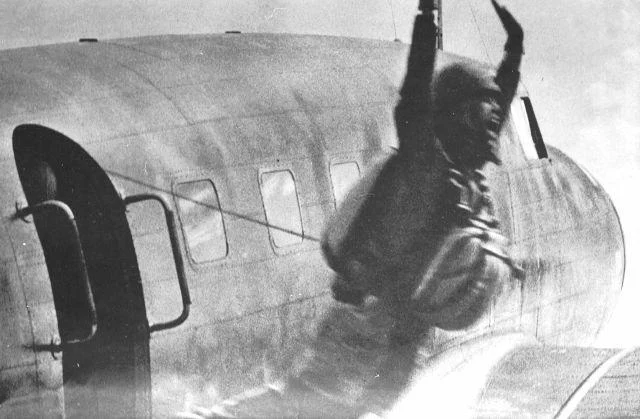 |
| Japanese paratrooper exits the Ki.56 transport during a jump. Most likely the photo was taken while the plane was still on the ground as this would be a nearly impossible shot to get in the air. |
 |
| A D3A2 taking off from one of the four airfields at Rabaul in 1943. The bomb carried under the port wing is noticeable. |
 |
| A D3A2 outward bound for Guadalcanal, in early 1943, with a 250 kilogram bomb under the fuselage. |
 |
| A line-up of D3A2s at the Misawa Air Base, in Japan’s northern Honshu, at the end of the Pacific war. Photograph taken on 20 October 1945. Propellers have been removed to prevent their being flown. |
 |
| Ki-84, 2nd Chutai, 47th Sentai, Home Defense, 1945. |
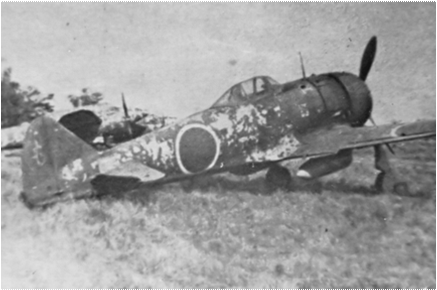 |
| Ki-84, 1st Sentai, Philippines, 1945. |
 |
| Two U.S.-captured Kugisho MXY7-K2 catapult trainers for the Ohka 43B Cherry Blossom bombers, resting on sawhorses, likely Yokosuka, Japan (near Tokyo), probably circa late 1945. |
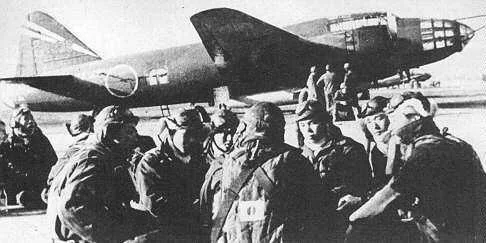 |
| A Betty bomber carrying a rocket-powered Ohka piloted bomb awaits as the bomber’s crew relaxes just prior to the start of a kamikaze mission. |
 |
| Mitsubishi Ki.21 “Sally” bombers approach Corregidor from the Bataan Peninsula in the north. |
 |
| Troops of the U.S. 158th Regimental Combat Team examine a wrecked Japanese “Sally” bomber, Kamiri Airfield, Noemfoor Island, July 1944. |
 |
| Mitsubishi Type 97 “Ann” light bombers of the 16th Sentai on their way for another raid on Bataan, 3 March 1942. |
 |
| Nakajima B5N2 Kates on their way to attack Pearl Harbor. |
 |
| Germans captured a Russian guerrilla, disguised as a woman, who was dropped by parachute behind the German lines on the Novorossisk front. |
 |
| German field artillery bombarding Calais. |
 |
| Left to right: Air Marshal Arthur W. Tedder, RAF, Brigadier General Strickland, USAAF, and Air Vice-Marshal Cunningham, RAF, Libya. |
 |
| A U.S. soldier inspects thousands of gold wedding bands taken from Jews by the Germans and stashed in the Heilbronn Salt Mines, on May 3, 1945 in Germany. |
 |
| The Imperial Japanese Navy's heavy cruiser Furutaka is refueling from the tanker Tsurumi. 1935. |
 |
| Two Luftwaffe sergeants wearing the summer flying suits with a 9mm Luger on their belt are helping each other to secure the parachute prior to a flight over the English Channel, early 1940. |
 |
| A member of the Luftwaffe exchanges gifts with a native in North Africa, 1941. |
 |
| Luftwaffe radio operators. |
 |
| Luftwaffenhelferin (air force helper). |
 |
| General Wladyslaw Sikorski, Commander-in-Chief of the Polish Armed Forces, inspects Polish airmen during their training in France, 15 April 1940. (Imperial War Museum) |



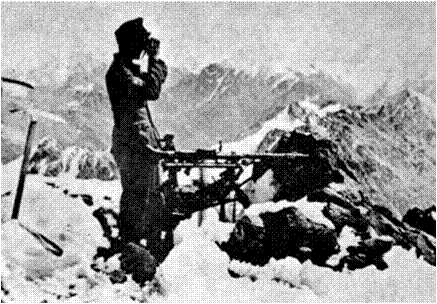











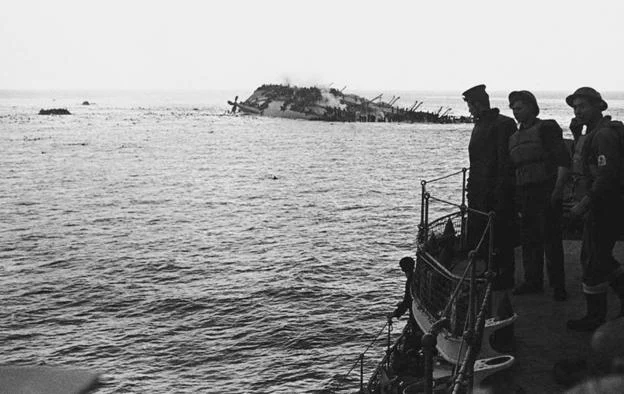







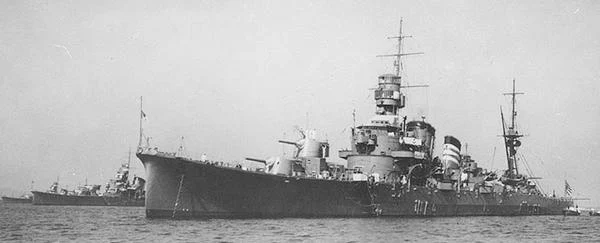


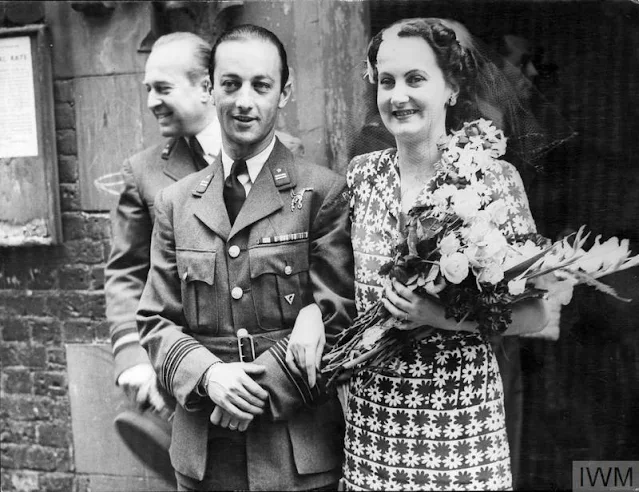




No comments:
Post a Comment